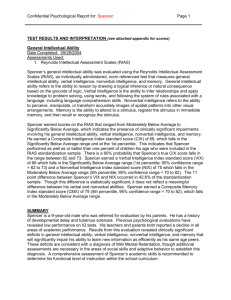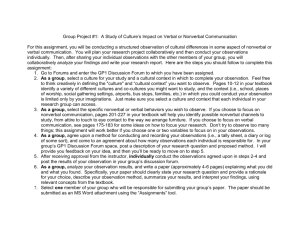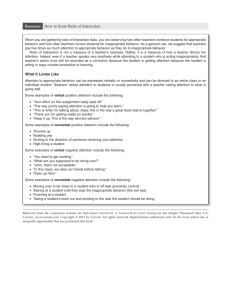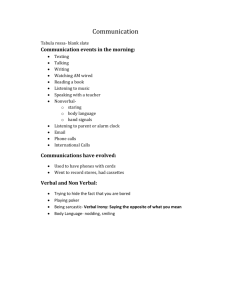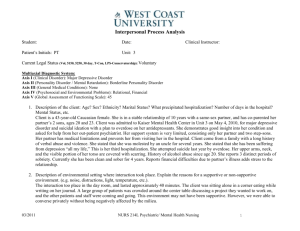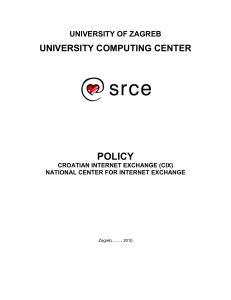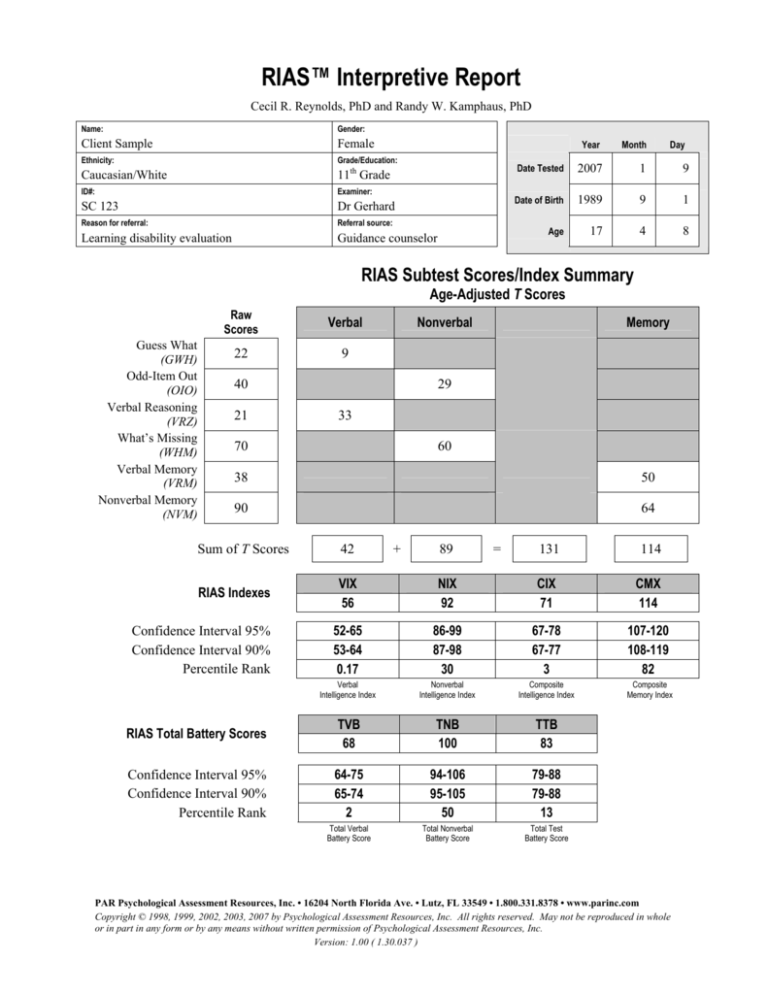
RIAS™ Interpretive Report
Cecil R. Reynolds, PhD and Randy W. Kamphaus, PhD
Name:
Gender:
Client Sample
Female
Ethnicity:
Grade/Education:
Caucasian/White
11th Grade
ID#:
Examiner:
SC 123
Dr Gerhard
Reason for referral:
Referral source:
Learning disability evaluation
Guidance counselor
Year
Month
Day
Date Tested
2007
1
9
Date of Birth
1989
9
1
Age
17
4
8
RIAS Subtest Scores/Index Summary
Age-Adjusted T Scores
Guess What
(GWH)
Odd-Item Out
(OIO)
Verbal Reasoning
(VRZ)
What’s Missing
(WHM)
Verbal Memory
(VRM)
Nonverbal Memory
(NVM)
Raw
Scores
Verbal
22
9
Nonverbal
40
21
Memory
29
33
70
60
38
50
90
64
Sum of T Scores
42
RIAS Indexes
VIX
56
131
114
NIX
92
CIX
71
CMX
114
52-65
53-64
0.17
86-99
87-98
30
67-78
67-77
3
107-120
108-119
82
Verbal
Intelligence Index
Nonverbal
Intelligence Index
Composite
Intelligence Index
Composite
Memory Index
RIAS Total Battery Scores
TVB
68
TNB
100
TTB
83
Confidence Interval 95%
Confidence Interval 90%
Percentile Rank
64-75
65-74
2
94-106
95-105
50
79-88
79-88
13
Total Verbal
Battery Score
Total Nonverbal
Battery Score
Total Test
Battery Score
Confidence Interval 95%
Confidence Interval 90%
Percentile Rank
+
89
=
PAR Psychological Assessment Resources, Inc. • 16204 North Florida Ave. • Lutz, FL 33549 • 1.800.331.8378 • www.parinc.com
Copyright © 1998, 1999, 2002, 2003, 2007 by Psychological Assessment Resources, Inc. All rights reserved. May not be reproduced in whole
or in part in any form or by any means without written permission of Psychological Assessment Resources, Inc.
Version: 1.00 ( 1.30.037 )
Client: Client Sample
Client ID: SC 123
Test Date: 01/09/2007
Page 2 of 13
RIAS Profiles
RIAS Subtest T scores
Score
≥ 90
RIAS Indexes
Score
≥ 90
80
Score
≥ 160
Score
≥ 160
150
150
140
140
130
130
120
120
80
70
70
NVM
WHM
60
60
CMX
110
50
50
100
110
100
VRM
NIX
40
90
90
80
80
40
VRZ
30
30
70
CIX
70
OIO
60
20
20
60
VIX
50
≤ 10
Scale GWH VRZ OIO WHM VRM NVM
Score 9
33
29
60
50
64
≤ 10
≤ 40
Index VIX
Score 56
50
≤ 40
NIX CIX CMX
92
71 114
Client: Client Sample
Client ID: SC 123
Test Date: 01/09/2007
Page 3 of 13
RIAS Total Battery Profiles
RIAS Subtest T scores
Score
≥ 90
RIAS Total Battery Scores
Score
≥ 90
80
Score
≥ 160
Score
≥ 160
150
150
140
140
130
130
120
120
110
110
80
70
70
NVM
WHM
60
60
TNB
VRM
50
50
40
100
100
90
90
40
TTB
80
80
VRZ
30
30
70
OIO
20
70
TVB
60
60
50
50
20
Client: Client Sample
Client ID: SC 123
Test Date: 01/09/2007
Page 4 of 13
Background Information
Client Sample is a 17-year-old female. She was referred by her guidance counselor for an initial
learning disability evaluation. Client is currently in the 11th grade. The name of Client’s school was
reported as “Lincoln High School.” Client’s parental educational attainment was reported as:
“College.” The primary language spoken in Client’s home is English.
Client identified the following vision, hearing, language, and/or motor problems: “Requires
prescription glasses for reading.” Client further identified the following learning problems: “None.”
Finally, Client identified the following medical/neurological problems: “None.”
Behavioral Observations
Client arrived more than 15 minutes early. She was accompanied to the session by her legal guardian.
During testing the following behavioral observations were made: “Client appeared easily distracted
and was very fidgety.”
Caveat and Descriptive Text
The test scores, descriptions of performance, and other interpretive information provided in this
computer report are predicated on the following assumptions. First, it is assumed that the various
subtests were administered and scored correctly in adherence with the general and specific
administration and scoring guidelines provided in chapter 2 of the RIAS/RIST Professional Manual
(Reynolds & Kamphaus, 2003). Second, it also is assumed that the examinee was determined to be
appropriately eligible for testing by the examiner according to the guidelines for testing eligibility
provided in chapter 2 of the RIAS Professional Manual and that the examiner was appropriately
qualified to administer and score the RIAS/RIST.
This report is intended for revelation, transmission to, and use by individuals appropriately qualified
and credentialed to interpret the RIAS/RIST under the laws and regulations of their local jurisdiction
and meeting the guidelines for use of the RIAS/RIST as stated in the RIAS Professional Manual
(Reynolds & Kamphaus, 2003) (see chapter 2).
Client was administered the Reynolds Intellectual Assessment Scales (RIAS). The RIAS is an
individually administered measure of intellectual functioning normed for individuals between the ages
of 3 and 94 years. The RIAS contains several individual tests of intellectual problem solving and
reasoning ability that are combined to form a Verbal Intelligence Index (VIX) and a Nonverbal
Intelligence Index (NIX). The subtests that compose the VIX assess verbal reasoning ability along
with the ability to access and apply prior learning in solving language-related tasks. Although labeled
the Verbal Intelligence Index, the VIX also is a reasonable approximation of crystallized intelligence.
The NIX comprises subtests that assess nonverbal reasoning and spatial ability. Although labeled the
Nonverbal Intelligence Index, the NIX also provides a reasonable approximation of fluid intelligence.
These two indexes of intellectual functioning are then combined to form an overall Composite
Intelligence Index (CIX). By combining the VIX and the NIX to form the CIX, a stronger, more
reliable assessment of general intelligence (g) is obtained. The CIX measures the two most important
aspects of general intelligence according to recent theories and research findings: reasoning or fluid
abilities and verbal or crystallized abilities. Each of these indexes is expressed as an age-corrected
Client: Client Sample
Client ID: SC 123
Test Date: 01/09/2007
Page 5 of 13
standard score that is scaled to a mean of 100 and a standard deviation of 15. These scores are
normally distributed and can be converted to a variety of other metrics if desired.
The RIAS also contains subtests designed to assess verbal memory and nonverbal memory.
Depending on the age of the individual being evaluated, the verbal memory subtest consists of a series
of sentences, age-appropriate stories, or both, read aloud to the examinee. The examinee is then asked
to recall these sentences or stories as precisely as possible. The nonverbal memory subtest consists of
the presentation of pictures of various objects or abstract designs for a period of 5 seconds. The
examinee is then shown a page containing six similar objects or figures and must discern which object
or figure was previously shown. The scores from the verbal memory and nonverbal memory subtests
are combined to form a Composite Memory Index (CMX), which provides a strong, reliable
assessment of working memory and also may provide indications as to whether or not a more detailed
assessment of memory functions may be required. In addition, the high reliability of the verbal and
nonverbal memory subtests allows them to be compared directly to each other.
For reasons described in the RIAS/RIST Professional Manual (Reynolds & Kamphaus, 2003), it is
recommended that the RIAS subtests be assigned to the indices described above (e.g., VIX, NIX, CIX,
and CMX). For those who do not wish to consider the memory scales as a separate entity and prefer to
divide the subtests strictly according to verbal and nonverbal domains, the RIAS subtests can be
combined to form a Total Verbal Battery (TVB) score and a Total Nonverbal Battery (TNB) score.
The subtests that compose the Total Verbal Battery score assess verbal reasoning ability, verbal
memory, and the ability to access and apply prior learning in solving language-related tasks. Although
labeled the Total Verbal Battery score, the TVB also is a reasonable approximation of measures of
crystallized intelligence. The TNB comprises subtests that assess nonverbal reasoning, spatial ability,
and nonverbal memory. Although labeled the Total Nonverbal Battery score, the TNB also provides a
reasonable approximation of fluid intelligence. These two indexes of intellectual functioning are then
combined to form an overall Total Test Battery (TTB) score. By combining the TVB and the TNB to
form the TTB, a stronger, more reliable assessment of general intelligence (g) is obtained. The TTB
measures the two most important aspects of general intelligence according to recent theories and
research findings: reasoning, or fluid, abilities and verbal, or crystallized, abilities. Each of these
scores is expressed as an age-corrected standard score that is scaled to a mean of 100 and a standard
deviation of 15. These scores are normally distributed and can be converted to a variety of other
metrics if desired.
Composite Norm-Referenced Interpretations
On testing with the RIAS, Client earned a Composite Intelligence Index or CIX of 71. On the RIAS,
this level of performance falls within the range of scores designated as moderately below average and
exceeds the performance of 3% of individuals at Client’s age. The chances are 90 out of 100 that
Client’s true CIX falls within the range of scores from 67 to 77.
Client earned a Verbal Intelligence Index (VIX) of 56, which falls within the significantly below
average range of verbal intelligence skills and exceeds the performance of less than one percent of
individuals Client’s age. The chances are 90 out of 100 that Client’s true VIX falls within the range of
scores from 53 to 64.
Client earned a Nonverbal Intelligence Index (NIX) of 92, which falls within the average range of
nonverbal intelligence skills and exceeds the performance of 30% of individuals Client’s age. The
chances are 90 out of 100 that Client’s true NIX falls within the range of scores from 87 to 98.
Client: Client Sample
Client ID: SC 123
Test Date: 01/09/2007
Page 6 of 13
Client earned a Composite Memory Index (CMX) of 114, which falls within the above average range
of working memory skills. This exceeds the performance of 82% of individuals Client’s age. The
chances are 90 out of 100 that Client’s true CMX falls within the range of scores from 108 to 119.
On testing with the RIAS, Client earned a Total Test Battery or TTB score of 83. This level of
performance on the RIAS falls within the range of scores designated as below average and exceeds the
performance of 13% of individuals at Client’s age. The chances are 90 out of 100 that Client’s true
TTB falls within the range of scores from 79 to 88.
Client’s Total Verbal Battery (TVB) score of 68 falls within the range of scores designated as
significantly below average and exceeds the performance of 2% of individuals her age. The chances
are 90 out of 100 that Client’s true TVB falls within the range of scores from 65 to 74.
Client’s Total Nonverbal Battery (TNB) score of 100 falls within the range of scores designated as
average and exceeds the performance of 50% of individuals her age. The chances are 90 out of 100
that Client’s true TNB falls within the range of scores from 95 to 105.
Subtest Norm-Referenced Interpretations
The Guess What subtest measures vocabulary knowledge in combination with reasoning skills that are
predicated on language development and acquired knowledge. On testing with the RIAS, Client
earned a T score of 9 on Guess What.
Odd-Item Out measures analytical reasoning abilities within the nonverbal domain. On testing with
the RIAS, Client earned a T score of 29 on Odd-Item Out.
Verbal Reasoning measures analytical reasoning abilities within the verbal domain. English
vocabulary knowledge is also required. On testing with the RIAS, Client earned a T score of 33 on
Verbal Reasoning.
What’s Missing measures spatial and visualization abilities. On testing with the RIAS, Client earned a
T score of 60 on What’s Missing.
Verbal Memory measures the ability to encode, briefly store, and recall information in the verbal
domain. English vocabulary knowledge also is required. On testing with the RIAS, Client earned a T
score of 50 on Verbal Memory.
Nonverbal Memory measures the ability to encode, briefly store, and recall information in the
nonverbal and spatial domains. On testing with the RIAS, Client earned a T score of 64 on Nonverbal
Memory.
RIAS Discrepancy Score Summary Table
Discrepancy Score
Score Difference
Statistically Significant?
VIX < NIX
CIX < CMX
VRM < NVM
TVB < TNB
36
43
14
32
yes
yes
yes
yes
Prevalence in
Standardization Sample
1.20%
1.30%
38.80%
4.70%
Client: Client Sample
Client ID: SC 123
Test Date: 01/09/2007
Page 7 of 13
VIX is the Verbal Intelligence Index, NIX is the Nonverbal Intelligence Index, CIX is the Composite Intelligence Index, CMX is the Composite Memory
Index, VRM is the Verbal Memory Subtest, NVM is the Nonverbal Memory Subtest, TVB is the Total Verbal Battery Index, and TNB is the Total
Nonverbal Battery Index.
Discrepancy Norm-Referenced Interpretations
Although the CIX is a good estimate of Client’s general intelligence, a statistically significant
discrepancy exists between her NIX of 92 and her VIX of 56, demonstrating better developed
nonverbal intelligence or spatial abilities. The magnitude of the difference observed between these
two scores is potentially important and should be considered when drawing conclusions about Client’s
current status. A difference of this size is relatively uncommon, occurring in only one percent of cases
in the general population. In such cases, interpretation of the CIX or general intelligence score may be
of less value than viewing Client’s verbal and nonverbal abilities separately.
When compared to Client’s measured level of general intelligence as reflected in Client’s CIX, it can
be seen that her CIX falls significantly below her CMX. This result indicates that Client is able to use
immediate recall and working memory functions at a level that significantly exceeds her ability to
engage in intellectual problem solving and general reasoning tasks. The magnitude of the difference
seen in this instance may take on special diagnostic significance due to its relative infrequency in the
general population. A difference between CIX and CMX of this magnitude occurs in only one percent
of the population.
Within the subtests making up the CMX, Client’s performance in the nonverbal memory domain
significantly exceeded her level of performance within the verbal memory domain. This difference is
reliable and indicates that Client functions at a significantly higher level when asked to recall or
engage in working memory tasks that are easily adapted to visual-spatial cues and other nonverbal
memory features, as opposed to tasks relying on verbal linguistic strategies. Although most likely
representing a real difference in Client’s abilities in these two areas, the magnitude of this difference is
relatively common, occurring in 39% of the population at Client’s age. Therefore, this difference may
or may not be indicative of the presence of a psychopathological condition, depending on the results of
other clinical assessment information.
Although the TTB is a good estimate of Client’s general intelligence, a significant discrepancy exists
between her TNB score of 100 and her TVB score of 68, demonstrating better developed nonverbal
intelligence or spatial abilities. The magnitude of the difference observed between these two scores is
potentially important and should be considered when drawing conclusions about Client’s current
status. A difference of this size is relatively uncommon, occurring in only 5% of cases in the general
population. In such cases, interpretation of the TTB or general intelligence score may be of less value
than viewing Client’s verbal and nonverbal abilities separately.
If interested in comparing the TTB and CIX scores or the TTB and CMX scores, it is better to compare
the CIX and CMX directly. As noted in the RIAS/RIST Professional Manual (Reynolds & Kamphaus,
2003), the TTB is simply a reflection of the sum of the T scores of the subtests that compose the CIX
and CMX. Thus, it is more appropriate to make a direct comparison of the CMX and CIX because any
apparent discrepancy between the TTB and the CIX or the TTB and the CMX will in fact be a
reflection of discrepancies between the CIX and the CMX, so this value is best examined directly. To
compare the CMX or CIX to the TTB may exaggerate some differences inappropriately.
Client: Client Sample
Client ID: SC 123
Test Date: 01/09/2007
Page 8 of 13
General Interpretive Caveats
Examiners should be familiar with the cultural and linguistic background of Client (which may
radically alter the suggestions contained herein) and be certain to consider these factors before arriving
at a final decision regarding any diagnosis, classification, or related decision and before making any
form of recommendations.
School Feedback and Recommendations
Composite Score Feedback and Recommendations
Client’s CIX score of 71 indicates moderate deficits in overall development of general intelligence
relative to others her same age and her TTB score of 83 indicates mild deficits in overall development
of general intelligence relative to others at Client’s age. Individuals earning general intelligence scores
in this range frequently experience at least some difficulty acquiring information through traditional
educational methods provided in the classroom setting.
The TTB measures the same general construct as the CIX with the exception that six tests are included
rather than four. Evidence in the RIAS/RIST Professional Manual (Reynolds & Kamphaus, 2003)
documents the equivalence of these two scores based on evidence that a first factor solution is
defensible at all age levels of the RIAS whether four or six subtests are used. There also is evidence
from a variety of intelligence tests to suggest the “indifference of the indicator” (Kamphaus, in press).
In other words, general intelligence may be assessed using a variety of cognitive tests providing further
evidence that for most individuals the TTB and CIX will be interchangeable. There will be exceptions
to this well-documented scientific finding, in the case of severe brain injury, for example, where
significant memory impairment may be present, but these cases will be exceptions rather than the rule.
Since most instructional programs presume at least average intellectual ability and involve lecture, note
taking and other typical instructional approaches, with the exception of demonstrative and repetitive
methods commonly used with young children, difficulties in acquiring information when these
methods are used is anticipated. Given Client’s deficits, special teaching methods might be
considered, including special class placement for severe deficits in general intellectual development.
Teachers should prepare an individualized curriculum designed for students who learn at a slower rate
then others of the same age and grade level. Alternative methods of instruction should be considered
that involve the use of repeated practice, spaced practice, concrete examples, guided practice, and
demonstrative techniques. Individuals with general intelligence scores in this range often benefit from
repeated practice approaches to training because of problems with acquisition and long-term retrieval,
as well as an individualized instructional method that differs significantly from that of their age-mates.
It also will be important to assist Client in developing strategies for learning and studying. Although it
is important for all students to know how to learn and not just what to learn, low scores on general
intelligence indices make the development of learning and study strategies through direct instruction
even more important. If confirmed through further testing, co-occurring deficits in adaptive behavior
and behavioral problems should be added to the school intervention program.
Client’s VIX score of 56 and TVB score of 68 indicate severe deficits in the development of verbal
intellect relative to others at Client’s age. Individuals at this score level on the TVB nearly always
have accompanying verbal memory difficulties that can easily be moderate to severe in nature. Special
Client: Client Sample
Client ID: SC 123
Test Date: 01/09/2007
Page 9 of 13
attention to Client’s VRM score is necessary, as well as considerations for any extant verbal memory
problems and their accompanying level of severity in making specific recommendations.
Verbal ability is important for virtually every aspect of activity because language is key to nearly all
areas of human endeavor. A multitude of research investigations have documented the importance of
verbal ability for predicting important life outcomes. Verbal ability should be considered equivalent to
the term “crystallized intelligence” (Kamphaus, in press). As assessed by the RIAS, verbal ability (like
crystallized intelligence) is highly related to general intelligence, and as such its relationship to
important life outcomes is easily correlated. Verbal ability also is the foundation for linguistic
knowledge, which is necessary for many types of learning.
With the exception of the early grades, along with kindergarten and pre-K settings, school is
principally a language-oriented task. Given Client’s relative verbal deficits, special teaching methods
might be considered, including special class placement in the case of severe deficits in verbal
intellectual development. The examiner should also consider either conducting, or making a referral
for, an evaluation for the presence of a language disorder. Alternative methods of instruction that
emphasize “show me” rather than “tell me” techniques, or as a minimum pair these two general
approaches, are preferred.
Although linguistic stimulation likely cannot counteract the effects of verbal ability deficits that began
in infancy or preschool years, verbal stimulation is still warranted to either improve adaptation or at
least prevent an individual from falling further behind peers. Verbal concept and knowledge
acquisition should continue to be emphasized. A simple word-for-the-day program may be beneficial
for some students. Verbal knowledge builders of all varieties may be helpful including defining
words, writing book reports, a book reading program, and social studies and science courses that
include writing and oral expression components. Alternatively, assistive technology (e.g., personal
digital assistance devices, tape recorders, MP3 players, or IPODs) may be used to enhance functioning
in the face of the extensive verbal demands required for making adequate academic progress.
In addition, teachers should rely more heavily on placing learning into the student’s experiential
context, giving it meaning and enabling Client to visualize incorporating each newly learned task or
skill into her life experience. The use of visual aids should be encouraged and made available to Client
whenever possible. Academic difficulties are most likely to occur in language-related areas (e.g., the
acquisition of reading), especially early phonics training. The acquisition of comprehension skills also
is aided when the verbal ability falls into this level by the use of language experience approaches to
reading, in particular. Frequent formal and informal assessment of Client’s reading skills, as well as
learning and study strategies (the latter with an instrument, e.g., the School Motivation and Learning
Strategies Inventory; SMALSI; Stroud & Reynolds, 2006) is recommended. This should be followed
by careful direct instruction in areas of specific skill weaknesses and the use of high interest, relevant
materials. It also will be important to assist Client in developing strategies for learning and studying.
Although it is important for all students to know how to learn and not just what to learn, low scores
within the verbal intelligence domains make the development of learning and study strategies through
direct instruction even more important.
Discrepancy Feedback and Recommendations
The magnitude of discrepancy between Client’s VIX score of 56 and NIX score of 92 as well as the
magnitude of the discrepancy between her TVB score of 68 and TNB score of 100 is relatively unusual
within the normal population. Although this is the most common pattern within referral populations,
Client: Client Sample
Client ID: SC 123
Test Date: 01/09/2007
Page 10 of 13
the magnitude of the discrepancy occurring for Client makes the difference noteworthy. In general,
this pattern represents substantially disparate skills in the general domains of verbal and nonverbal
reasoning, with clear superiority evident in the nonverbal domain. Relative to their verbal reasoning
and general language skills, individuals who display this pattern will experience greater success in
tasks involving spatial reasoning, visualization skills, the use of mental rotation, reading of nonverbal
cues, and related aspects of nonverbal reasoning and communication usually including nonverbal and
visual memory skills. Nonverbal ability is less influential in other’s appraisal of general intellectual
functioning. Because NIX and TNB are greater than VIX and TVB, Client’s general intellectual
functioning may appear lower than is reflected by her CIX and TTB scores. Whenever possible, one
should take advantage of Client’s relatively higher levels of performance in the nonverbal domain by
always providing visual cues and explanations of tasks, expectations, or demonstrations of what is
expected to be learned. Experiential learning is typically superior to traditional lecture and related
pedagogical methods for individuals with this score pattern. Synthesis of information as opposed to
analysis is often a relative strength, as well.
Teaching should emphasize the use of visual images, spatial representations of relationships,
experiential learning, and the synthesis of information as opposed to methods of deduction in learning.
Difficulties are likely to occur with traditional pedagogical styles such as lecturing and the completion
of reading and written assignments. An emphasis on the spatial relationships of numbers and the
construction of problems is likely to be the most effective means for teaching math versus the
memorization and the learning of step-by-step rules for calculation. A heavy emphasis on learning by
example and by demonstration is likely to be most effective with students with this intellectual pattern.
Also common are problems with sequencing including sequential memory and, in the early grades,
mastery of phonics when synthesizing word sounds into correct words. Emphases on holistic methods
of learning are likely to be more successful in addition to experiential approaches. The practical side
of learning and the application of knowledge can be emphasized to enhance motivation in these
students.
Often, these students do not have good study, learning, and test-taking strategies. It is often useful to
assess the presence of strategies with a scale such as the School Motivation and Learning Strategies
Inventory and then to target deficient areas of learning strategies for direct instruction (Stroud &
Reynolds, 2006).
The magnitude of discrepancy between Client’s CMX score of 114 and CIX score of 71 is relatively
unusual within the normative population, suggesting that memory skills are relatively more intact than
general intellectual skills. Individuals with this profile may require more intensive and broad-based
intervention because general intelligence is a better predictor of occupational and educational
outcomes than are memory skills (Kamphaus, in press).
Students with this profile may experience problems with inferential reasoning, logic, the
comprehension of new concepts, and the acquisition of new knowledge. As such, participation in
school or intervention programs is often more successful if lessons are of longer duration, information
is provided in multiple modalities, opportunities to practice newly acquired skills are provided
frequently, and repetition and review is emphasized.
Recommendations for Additional Testing
Client’s NIX score of 92 and her TNB score of 100 are significantly higher than her VIX score of 56
score and her TVB score of 68. Although this is the most common pattern in referral populations,
Client: Client Sample
Client ID: SC 123
Test Date: 01/09/2007
Page 11 of 13
additional information is almost always helpful in making a diagnosis, in treatment planning, and/or in
making vocational recommendations. Evaluations that consider disturbances in language and verbal
functions in general (including receptive and expressive language) and other left hemisphere related
tasks may prove helpful. Although empirical research at this point is lacking, clinical experience with
the RIAS indicates that when the VIX score is significantly below the NIX score and the absolute
value of the VIX is less than 90, there is a high probability of the presence of a language disorder that
may have an adverse impact on academic attainment or success in any academically related vocational
training program. When this pattern occurs, as in the case of Client, screening for a language disorder
is recommended at a minimum and a more comprehensive language assessment should be considered.
Evaluation of language skills with measures such as the Clinical Evaluation of Language
Fundamentals 4 (CELF-4; Semel, Wiig, & Secord; 2004), age appropriate language tasks from the
Halstead-Reitan Neuropsychological Test Battery (e.g., the Speech Sounds Perception Test, Aphasia
Screening Test; Reitan & Wolfson; 1993), the Comprehensive Receptive and Expressive Vocabulary
Test (CREVT-2; Wallace & Hammill; 2002), and the Developmental Test of Auditory Perception
(DTAP; Reynolds, Voress & Pierson, 2007), may be particularly useful. Other tests of specific
cognitive-processing functions should be considered. Research suggests that cognitive processing is
measured well with little confounding by level of general intelligence through the use of
comprehensive measures of memory functions including the WRAML-2 (Sheslow & Adams; 2003)
and the TOMAL-2 (Reynolds & Voress, 2007). Subtests of the Neuropsychological Assessment
(NAB; Stern & White; 2003), and other related tests of verbal skills with which you are familiar and
skilled may well be useful adjuncts to the assessment process in the case of Client. Students with this
pattern often exhibit inadequate levels of study-skills development and learning strategies and, thus,
may become discouraged in school or vocational-training programs. Assessment and targeted
remediation of such deficits can be undertaken for ages 8 years through 18 years with assessments such
as the School Motivation and Learning Strategies Inventory (Stroud & Reynolds, 2006).
In cases where the CMX score is clinically significantly higher than the CIX score, follow-up
evaluation may be warranted, particularly if the CIX is in the below average range or lower. Lower
intelligence test scores are associated with increased forms of a variety of psychopathology,
particularly if scores are in or near the mental retardation range (Kamphaus, in press). Because general
intelligence impacts knowledge and skill acquisition in a variety of areas, a thorough evaluation of
academic achievement is necessary to gauge the impact of any impairment and make plans to
remediate educational weaknesses.
Client: Client Sample
Client ID: SC 123
Test Date: 01/09/2007
Page 12 of 13
RIAS Extended Score Summary Table
Score
GWH
OIO
VRZ
WHM
VRM
NVM
VIX
NIX
CIX
CMX
TVB
TNB
TTB
Raw score
22
40
21
70
38
90
T score
9
29
33
60
50
64
21
45
31
59
29
50
39
≤-4.00
-2.10
-1.70
1.00
0.00
1.40
-2.93
-0.53
-1.93
0.93
-2.13
0.00
-1.13
≤1
4
5
13
10
14
Sum of subtest
T scores
42
89
131
114
92
153
245
Index score
56
92
71
114
68
100
83
Percentile rank
0.17
30
3
82
2
50
13
95% confidence
interval
52-65
86-99
67-78
107-120
64-75
94-106
79-88
53-64
87-98
67-77
108-119
65-74
95-105
79-88
1
39
9
70
5
50
26
1
4
1
7
1
5
3
(Mean = 50, SD = 10)
z score
(Mean = 0, SD = 1)
Subtest
scaled score
(Mean = 10, SD = 3)
(Mean = 100, SD = 15)
90% confidence
interval
NCE
(Mean = 50, SD =
21.06)
Stanine
(Mean = 5, SD = 2)
Client: Client Sample
Client ID: SC 123
Test Date: 01/09/2007
Page 13 of 1
References
Hammill, D. & Bryant, B. (2005). Detroit Tests of Learning Aptitude-Primary (DTLA-P-3)
(3rd ed.). Austin, TX: PRO-ED.
Hammill, D., Pearson, N. A., & Voress, J. K. (1993). Developmental Test of Visual Perception-2
(DTVP-2). Austin, TX: PRO-ED.
Kamphaus, R. W. (in press). Clinical assessment of children's intelligence (3rd ed.).
New York: Springer.
McCarthy, D. (1972). McCarthy Scales of Children’s Abilities. San Antonio, TX: Harcourt
Assessment.
Reitan, R. M. & Wolfson, D. (1993). The Halstead-Reitan Neuropsychological Test Battery: Theory
and clinical interpretation (2nd ed.). Tucson, AZ: Neuropsychology Press.
Reynolds, C. R. (2006). Koppitz Developmental Scoring System for the Bender Gestalt Test
(Koppitz-2) (2nd ed.). Austin, TX: PRO-ED.
Reynolds, C. R., & Kamphaus, R. W. (2003). Reynolds Intellectual Assessment Scales (RIAS) and the
Reynolds Intellectual Screening Test (RIST) professional manual.
Lutz, FL: Psychological Assessment Resources.
Reynolds, C.R., Pearson, N.A., & Voress, J.K. (2002). Developmental Test of Visual Perception –
Adolescent and Adult (DTVP-A). Austin, TX: PRO-ED.
Reynolds, C. R., & Voress, J. (2007). Test of Memory and Learning (TOMAL-2) (2nd ed.). Austin,
TX: PRO-ED.
Reynolds, C. R., Voress, J., & Pierson, N. (2007). Developmental Test of Auditory Perception
(DTAP). Austin, TX: PRO-ED.
Semel, E. M., Wiig, E. H., & Secord, W. A. (2004). Clinical Evaluation of Language Fundamentals 4
– Screening Test (CELF-4). San Antonio, TX: Harcourt Assessment.
Sheslow, D., & Adams, W. (2003). Wide Range Assessment of Memory and Learning 2 (WRAML-2).
Wilmington, DE: Wide Range.
Stern, R.A. & White, T. (2003). Neuropsychological Assessment Battery (NAB). Lutz, FL:
Psychological Assessment Resources.
Stroud, K., & Reynolds, C. R. (2006). School Motivation and Learning Strategies Inventory
(SMALSI). Los Angeles: Western Psychological Services.
Wallace, G. & Hammill, D. D. (2002). Comprehensive Receptive and Expressive Vocabulary Test,
(CREVT-2) (2nd ed.). Los Angeles: Western Psychological Services.
End of Report


